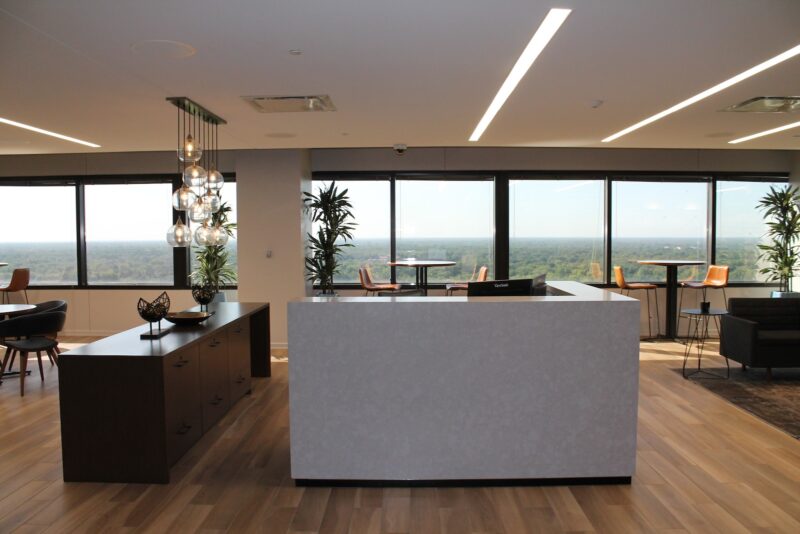Running an office can be expensive, and one of the largest overheads for many businesses is energy costs. With electricity prices on the rise and a growing awareness of the need to reduce our carbon footprint, finding ways to save energy in the workplace has become increasingly important. In this article, we’ll explore ten tips for reducing energy costs in your UK office, helping you to save money and reduce your environmental impact.
Reduce your energy costs even further by getting the best energy contracts. Click here for business energy quotes!
1. Switch to LED Lighting
One of the easiest ways to save energy in your office is by replacing traditional incandescent or halogen bulbs with energy-efficient LED lights. LEDs use up to 90% less energy than traditional bulbs and last much longer, meaning you won’t need to replace them as often. This simple change can make a significant difference to your energy costs and reduce your office’s carbon footprint.
2. Regularly Maintain Heating and Cooling Systems
Heating and cooling systems are often major contributors to high energy bills. To ensure they’re running efficiently, it’s essential to perform regular maintenance, such as cleaning filters and checking for leaks. By keeping these systems in good working order, you’ll not only save energy but also extend the lifespan of your equipment, saving you money in the long run.
3. Install a Smart Thermostat
Smart thermostats allow you to control your office’s heating and cooling more effectively, helping you to save energy and reduce costs. These devices can learn your office’s usage patterns and adjust the temperature accordingly, ensuring the space is comfortable when occupied and conserving energy when empty. Some smart thermostats even offer remote access, allowing you to adjust settings from anywhere using a smartphone or tablet.
4. Encourage Energy-Saving Behaviours
One of the most effective ways to reduce energy costs in your office is by encouraging employees to adopt energy-saving behaviours. By promoting a culture of energy efficiency, you can create a more sustainable and cost-effective workplace. Here are some energy-saving behaviours to encourage among your employees:
- Turning off lights when leaving a room or when natural light is sufficient.
- Switching off computers, monitors, and other electronic devices when not in use or at the end of the day.
- Unplugging chargers and other devices when they’re not in use to avoid “phantom” energy consumption.
- Closing blinds or curtains to reduce heat gain during the summer months and heat loss during the winter months.
- Using power strips with built-in timers or auto shut-off features for shared equipment like printers and coffee machines.
- Taking advantage of energy-saving settings on computers, printers, and other devices.
- Encouraging the use of stairs instead of elevators to save electricity and promote physical activity.
- Reporting any issues with heating, cooling, or lighting systems to ensure they are addressed promptly.
- Avoiding the use of space heaters, which consume a large amount of energy and can be unsafe if not used properly.
- Sharing best practices and ideas for saving energy with colleagues, fostering a collaborative approach to energy efficiency.
Consider providing training or resources to educate staff on the importance of energy efficiency and how they can contribute to reducing the office’s energy consumption. You could also implement an incentive program or recognition system to reward employees who consistently demonstrate energy-saving behaviours, further motivating them to make a positive impact on your office’s energy usage.
5. Invest in Energy-Efficient Office Equipment
When it’s time to replace office equipment, consider opting for energy-efficient models that consume less power. Look for products with the Energy Star label, which indicates they meet strict energy efficiency guidelines set by the European Union. While these products may be slightly more expensive upfront, the long-term energy savings will often outweigh the initial cost.
6. Use Natural Light Where Possible
Maximising the use of natural light in your office can significantly reduce your reliance on artificial lighting, cutting energy costs in the process. Ensure windows are unobstructed to allow sunlight to enter the space and consider installing light shelves or other daylighting techniques to distribute natural light more evenly throughout the office. You may also want to rearrange workstations to take advantage of natural light sources.
7. Implement a Power Management Plan
Creating a power management plan for your office can help you identify areas where energy is being wasted and implement strategies to reduce consumption. This might include setting computer monitors to enter sleep mode after a period of inactivity, programming photocopiers to switch off overnight, or installing timers on vending machines and water coolers. Regularly review and update your power management plan to ensure it remains effective as your office’s needs change.
8. Insulate and Draught-Proof Your Office
Poor insulation and draughts can cause significant heat loss, leading to higher energy bills as your heating system works harder to maintain a comfortable temperature. Ensure your office is well insulated by checking for gaps around windows and doors, and sealing them with weatherstripping or draught excluders. You may also want to consider upgrading your office’s insulation, particularly if it’s an older building with poor energy efficiency.
9. Monitor and Track Energy Usage
Keeping a close eye on your office’s energy usage can help you identify patterns and trends that may be contributing to high energy costs. Consider installing energy monitoring devices or using software to track consumption, allowing you to spot inefficiencies and take action to reduce energy waste. Regularly review this data and use it to inform your energy-saving strategies.
10. Consider Renewable Energy Sources
Finally, you may want to explore the potential of renewable energy sources to reduce your office’s reliance on grid electricity and lower your energy bills. Solar panels, for example, can be installed on your office’s roof or grounds, generating clean, renewable energy to power your workspace. While there is an upfront cost involved in installing these systems, the long-term savings and environmental benefits can make them a worthwhile investment.
In conclusion, reducing energy costs in your UK office doesn’t have to be complicated or expensive. By implementing these ten tips, you can save money, improve your office’s energy efficiency, and contribute to a more sustainable future. Start by making small changes and gradually work towards more significant investments, such as upgrading equipment and exploring renewable energy options. With a little effort, you’ll soon see the benefits of a more energy-efficient office.



